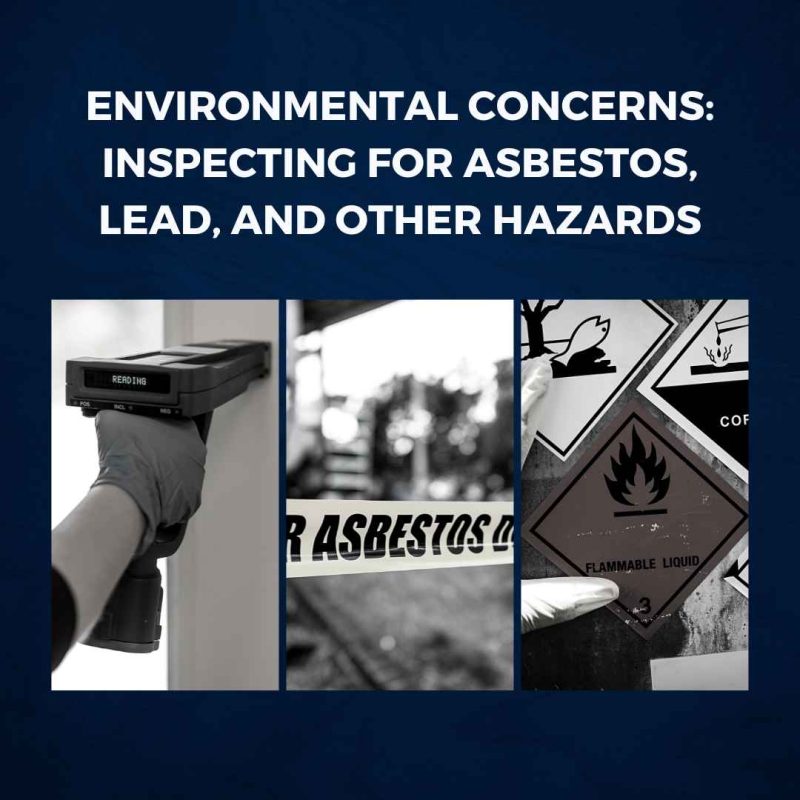Environmental safety has become a focal point for homeowners and potential buyers alike. As the repercussions of neglecting environmental hazards have come to the fore, the importance of inspecting for contaminants such as asbestos, lead, and other potential dangers has grown exponentially. These environmental hazards not only impact our health but can also affect the value of a property. Let’s explore these concerns in detail.
1. Asbestos Inspection
Understanding Asbestos:
Asbestos is a naturally occurring mineral fiber that was extensively used in a range of building materials and insulation up until the late 1970s, primarily because of its fire-resistant properties. However, if asbestos-containing materials break down or are damaged, microscopic fibers can become airborne and, when inhaled, can lead to severe health problems, including asbestosis, lung cancer, and mesothelioma.
Professional asbestos inspectors begin with a visual examination, followed by the collection of samples from suspected areas. These samples are then analyzed in a laboratory setting.
Post-inspection Measures:
If asbestos is found, removal isn’t always necessary. Sometimes, encapsulating or sealing the asbestos-containing materials is enough. However, if the property requires asbestos abatement, it’s crucial to employ licensed professionals to ensure safe removal.
2. Lead Inspections
Why is Lead a Concern?
Used predominantly in paints before 1978, lead can pose significant health risks if ingested or inhaled. Young children are particularly vulnerable, with exposure potentially leading to behavioral problems, learning disabilities, and other health issues.
The Inspection Process:
Lead inspections are primarily focused on homes built before the 1980s. Professionals use X-ray fluorescence (XRF) devices to detect the presence of lead in paints. Additionally, dust wipe samples may be taken, especially in areas where paint deterioration is evident.
Post-inspection Measures:
If lead-based paint is in good condition, it might be best to leave it undisturbed but monitored. However, if it’s chipping or deteriorating, it should either be encapsulated with a specialized product or professionally removed.
3. Other Environmental Hazards
Apart from asbestos and lead, other environmental concerns include:
Mold: Although previously discussed, it’s worth noting that prolonged exposure to certain mold types can lead to respiratory issues.
Volatile Organic Compounds (VOCs): These are gases emitted from certain solids or liquids inside homes, including paints, cleaning supplies, and even some carpets. Prolonged exposure can lead to health issues.
Carbon Monoxide: Often dubbed the “silent killer,” carbon monoxide is an odorless, colorless gas that can cause sudden illness or death if inhaled in large quantities.
Inspecting and Addressing These Concerns:
For mold, professional inspections involve visual examinations and air quality tests. For VOCs, improving ventilation and using low-VOC products can mitigate risks. Carbon monoxide detectors are essential for every home, ensuring early detection and prevention of potential tragedies.
Conclusion
Environmental hazards in homes, if undetected, can pose severe health risks. It’s vital for homeowners, especially those in older houses, to understand these concerns and take proactive steps to ensure safety. Regular inspections, conducted by certified professionals, can detect and address these hazards, providing peace of mind for inhabitants. If buying or selling a property, these inspections can also significantly influence its market value, making it an essential step in the real estate transaction process. Remember, the home should be a sanctuary; keeping it free from potential hazards is paramount.

